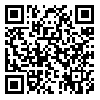BibTeX | RIS | EndNote | Medlars | ProCite | Reference Manager | RefWorks
Send citation to:
URL: http://jdisabilstud.org/article-1-3090-en.html
2- Assistant Professor, Department of Psychology, Tafresh Branch, Islamic Azad University, Tafresh, Iran
3- Assistant Professor, Department of Psychology, Shahrood Branch, Islamic Azad University, Shahrood, Iran
Abstract
Background & Objectives: The most common eating disorder is binge eating, seen in obese or overweight people. In the etiology of this disorder, unlike most other disorders, social and cultural factors play a greater role than psychological and biological factors. Therefore, the present study aimed to provide a model of irrational eating beliefs based on the attitude towards eating with the mediating role of body image flexibility in people with binge eating symptoms.
Methods: The research method was analytical in nature using structural equation modeling. The statistical population of this research comprised all the people with symptoms of binge eating who were referred to counseling centers in areas 6 and 12 of Tehran City, Iran, in 2021. To select the sample size in modeling research, 15 people are needed for each obvious variable. Also, based on the variables in the conceptual model of Figure 1, there are 7 obvious variables. Therefore, 105 people were needed in this research. However, due to the dropout and the possibility of not completing all the questions of the questionnaires, 200 questionnaires were distributed, out of which 185 questionnaires were completed and could be analyzed. The inclusion criteria were the minimum level of diploma education, not suffering from a specific physical disease or psychological disorder, and not undergoing psychological treatment or special medication. The exclusion criterion includes non–cooperation in completing the questionnaires. To collect the study data, the Body Image Flexibility Questionnaire (Sandoz et al., 2013), the Eating Attitude Questionnaire (Garner et al., 1983), and the Irrational Food Beliefs Questionnaire (Osberg et al., 2008) were used. This research used descriptive statistics, including mean and standard deviation. Also, the Kolmogorov–Smirnov test was used to determine the normality of the data. The Pearson correlation coefficient was used to determine the relationships between study variables and compile the structural equation modeling. The goodness–of–fit indexes of the model were evaluated based on the ratio of the Chi–square to degrees of freedom (CMIN/df), comparative fit index (CFI), goodness–of–fit index (GFI), adjusted goodness–of–fit index (AGFI) and root mean square error of approximation (RMSEA). If the Chi–square ratio index on the degree of freedom is less than 3, it indicates a favorable fit. The fit is very good if the GFI, AGFI, and CFI indices are greater than 0.95 and the RMSEA index is less than 0.05. Also, if the CFI, AGFI, and GFI indices are greater than 0.90 and the RMSEA index is less than 0.08, it indicates a good and favorable fit. In addition, the bootstrap test was used to estimate the indirect effects. Data were analyzed using SPSS version 24 and AMOS software version 24. The significance level of all tests was considered 0.05.
Results: Examining the coefficients of the direct paths between different variables showed that attitude towards eating and body image flexibility (p<0.001, Beta=6.4) and body image flexibility and irrational eating beliefs (p<0.001, Beta=3.3) had a significant direct relationship. Also, the goodness of fit indices has supported the good fit of the model with the collected data. By examining the fit indices of the model, it can be found that the Chi–square, which was the result of the ratio of CMIN/df, was at an acceptable threshold and showed the overlap between the theoretical model and the research data. However, due to the effectiveness of this index, other indices were used from the sample size. Examining other indicators shows that among them, the root mean square error of approximation (RMSEA=0.02), normed goodness of fit (NFI=0.93), and goodness of fit index (GFI=0.89) were within the permissible and acceptable limits. Considering that most fit indices were within the permissible range, the collected data were compatible with the proposed research model. Therefore, the proposed model was supported and not rejected.
Conclusion: The results of the study showed that the flexibility of body image in people with binge eating symptoms mediates the relationship between eating attitude and irrational eating beliefs.
| Rights and permissions | |
 |
This work is licensed under a Creative Commons Attribution-NonCommercial 4.0 International License. |



